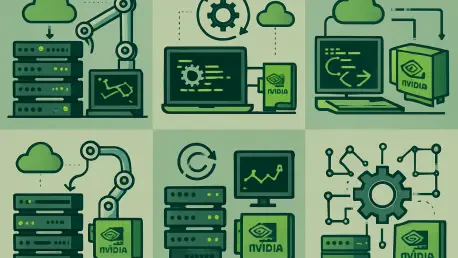In an era where digital infrastructure underpins nearly every aspect of business and technology, the demand for seamless, error-free network management has never been higher, especially as networks today grow more complex and software-driven. These intricate systems require innovative approaches to handle configuration, deployment, and maintenance at scale. Enter Continuous Integration and Continuous Delivery/Deployment (CI/CD), a set of practices originally rooted in software development that are now transforming how network engineers operate. By integrating CI/CD with advanced simulation tools like the NVIDIA Air digital twin platform, the automation of network processes becomes not just feasible, but highly efficient. This powerful combination promises to reduce errors, accelerate deployments, and enhance scalability, catering to the needs of modern data centers and beyond. As network automation continues to evolve, understanding and adopting these methodologies is becoming essential for staying ahead in a fast-paced technological landscape.
1. Embracing CI/CD for Network Automation
The concept of CI/CD has long been a cornerstone in software development, focusing on frequent, reliable delivery of code changes through automated processes. For network engineers, this methodology is gaining traction as networks increasingly rely on software-defined architectures. CI/CD offers a structured approach to managing network configurations and scripts, ensuring that changes are tested and deployed with precision. With tools like Cumulus Linux, which leverages Linux-based automation capabilities, the alignment between software engineering practices and network operations is seamless. This shift is critical as it allows for faster adaptation to changing requirements in dynamic environments, reducing the time between ideation and implementation. By adopting these practices, network teams can address challenges such as misconfigurations or delays that often plague manual processes, paving the way for more robust and responsive systems.
Beyond the conceptual benefits, the practical application of CI/CD in network automation involves integrating with platforms that enhance simulation and testing. The NVIDIA Air digital twin platform stands out as a key enabler, providing a virtual environment to replicate complex data center networks. This synergy allows engineers to simulate configurations before deployment, identifying potential issues in a risk-free setting. Unlike traditional methods that might require physical hardware for testing, this approach minimizes downtime and resource costs. Additionally, it fosters collaboration between development and operations teams by embedding network tasks into broader DevOps workflows. As a result, visibility and governance improve, ensuring that every change is traceable and aligned with organizational goals. This integration marks a significant step toward modernizing network management in an increasingly digital world.
2. Defining the CI/CD Pipeline in Network Contexts
A CI/CD pipeline serves as the backbone of automated software delivery, ensuring that code undergoes rigorous testing, validation, and deployment across multiple environments in a consistent manner. In the realm of network automation, this translates to a systematic process for handling configurations and scripts with the same rigor as application code. The pipeline comprises two core components: Continuous Integration (CI), which focuses on frequent merging and testing of code changes, and Continuous Delivery/Deployment (CD), which automates the packaging and rollout of these changes to testing, staging, and production environments. For network professionals, this means a reliable framework to deploy configurations without the unpredictability of manual intervention, enhancing operational efficiency across the board.
The benefits of implementing a CI/CD pipeline in network settings are manifold, particularly when managing large-scale or rapidly evolving infrastructures. Speed is a primary advantage, as automated processes drastically reduce the time needed to roll out updates or fixes. Quality is equally critical, with built-in validations and checks minimizing human error in configurations. Reliability comes from standardized workflows that eliminate surprises during production deployments, while scalability ensures that growing network demands are met without proportional increases in effort or cost. By leveraging these pipelines, network teams can handle intricate setups with ease, ensuring that each deployment aligns with expected outcomes. This structured approach is especially valuable when paired with systems like Cumulus Linux, which natively supports automation through its Linux foundation.
3. Why CI/CD Matters for Network Operations
The adoption of CI/CD in network automation is driven by compelling advantages that address core challenges in managing modern infrastructures. Speed stands out as a critical factor, enabling rapid iterations and deployment of changes to keep pace with dynamic business needs. Quality is enhanced through automated linting and validation processes that catch errors before they impact operations. Reliability is ensured by consistent, repeatable processes that reduce unexpected issues in production environments. Scalability, meanwhile, allows network teams to support expanding infrastructures and diverse use cases without being overwhelmed by complexity. These benefits collectively transform how network changes are implemented, making CI/CD an indispensable tool for staying competitive in a technology-driven landscape.
Cumulus Linux plays a pivotal role in this transformation, offering a network operating system deeply rooted in Linux principles that natively supports automation and scripting. This compatibility allows network automation to mirror software engineering workflows, fostering a cohesive environment where CI/CD practices thrive. By treating network configurations as code, changes can be managed through version control systems like Git, ensuring traceability and facilitating peer reviews. This integration not only streamlines operations but also bridges the gap between network and development teams, embedding network tasks into broader DevOps initiatives. The result is a more agile, error-resistant approach to network management that aligns with the demands of modern data centers and enterprise environments.
4. Practical Applications of CI/CD in Network Automation
Treating network configurations as code marks a fundamental shift in how changes are managed, leveraging version control systems like Git for traceability, review, and testing. This approach aligns network operations with DevOps practices, enhancing visibility and governance across teams. In the CI phase, code changes are automatically verified for validity, with artifacts such as automation scripts or config files undergoing linting and format checks for consistency in formats like YAML or Jinja2 templates. These templates enable dynamic configuration generation based on variables like topology or node roles, reducing manual errors and increasing flexibility. This methodical process ensures that network configurations are not static but adaptable to varying conditions, providing a robust foundation for automation.
In the CD phase, validated configurations are automatically deployed to testing and production environments using specialized tools and scripts. Logging and debug mechanisms are integrated into the pipeline to identify issues early, while health checks confirm successful deployment across all network nodes. A key element in many setups is the configuration file, such as .gitlab-ci.yml in GitLab CI/CD, which defines pipeline stages, jobs, and execution logic. While detailed structuring of such files will be explored in future discussions, understanding their role as the blueprint for automation workflows is essential. This phase ensures that deployments are not only automated but also monitored for consistency, minimizing the risk of disruptions in live environments and supporting seamless network operations.
5. Enhancing Validation through Automated Testing
Automated testing and verification are critical components of CI/CD pipelines in network automation, ensuring that configurations meet operational standards before reaching production. This process involves running show commands across devices to gather status information and parsing outputs to verify success criteria, such as active interfaces or established BGP neighbors. By flagging potential issues at this stage, failed deployments can be intercepted early, preventing costly disruptions. This systematic validation provides a safety net for network changes, ensuring that only thoroughly vetted configurations move forward in the pipeline, thus maintaining the integrity of the network infrastructure.
The continuous feedback generated through automated testing is invaluable for monitoring network health and preventing misconfigurations from propagating. Unlike manual checks, which are prone to oversight and inconsistency, automated validation offers a reliable, repeatable method to assess network status. This approach not only reduces the likelihood of errors but also frees up valuable time for network engineers to focus on strategic tasks rather than troubleshooting. By embedding such rigorous testing into CI/CD workflows, organizations can achieve a higher standard of operational excellence, ensuring that network changes align with design expectations and performance goals.
6. Leveraging NVIDIA Air for Network Simulation
The NVIDIA Air digital twin platform represents a cutting-edge solution for simulating complex data center networks, supporting environments with Cumulus Linux, SONIC, and host operating systems. Topologies can be created using a user-friendly graphical interface with drag-and-drop functionality or programmatically via JSON/DOT files. Automation is facilitated through a REST API for detailed control and a Python SDK that offers simplified abstractions for pipeline integration. These tools enable CI/CD pipelines to spin up topologies, apply configurations, run validation scripts, and tear down labs for repeatable testing, making NVIDIA Air a powerful ally in network automation.
Practical use cases for combining CI/CD with NVIDIA Air are diverse and impactful. Config integration ties generation directly into automation pipelines for seamless updates. Workshops and demos benefit from auto-generated, consistent labs for training or presentations. Partner solutions can leverage shareable templates to deliver custom topologies, while automated testing validates changes across varied setups without manual effort. This synergy between simulation and CI/CD practices allows for rapid iteration and validation in a controlled environment, reducing risks and enhancing deployment confidence in real-world scenarios.
7. Step-by-Step CI/CD Pipeline for Data Center Simulation
Implementing a CI/CD pipeline with NVIDIA Air for data center simulation involves a structured sequence of steps to ensure accuracy and efficiency. The process begins by retrieving relevant repositories from multiple Git sources, including AIR automation code, network configurations, topology files, and Jinja2 templates. Next, config file syntax and formatting are validated to confirm that topology files meet standards and can be parsed by the Air API. The topology is then created as an AIR simulation using a DOT or JSON file, with parameters like organization selection or simulation expiry adjusted as needed. This initial setup establishes a solid foundation for the simulation process, ensuring all components are aligned with design requirements.
Following setup, the simulation is launched via API calls, and rendered configurations are applied to network devices and servers. Validation ensues with show commands and ping tests to verify that cabling and design match expectations. Finally, the simulation is saved for future reference and shut down to conserve resources. This end-to-end workflow exemplifies how CI/CD pipelines can automate complex network simulations, reducing manual intervention and enhancing precision. By following these steps, network teams can replicate real-world scenarios in a virtual environment, identifying potential issues before they impact production and ensuring robust network performance.
8. Reflecting on the Impact of CI/CD in Networks
Looking back, the integration of CI/CD pipelines into network automation marked a pivotal shift in how digital infrastructures were managed. These practices, long established in software engineering, proved to be transformative when paired with platforms like Cumulus Linux and NVIDIA Air. They brought unprecedented agility to network operations, allowing teams to deploy changes with confidence and minimal errors. The ability to simulate and validate configurations in virtual environments before production rollout minimized risks and optimized resource use, setting a new standard for efficiency in data center management.
As a forward-looking consideration, network professionals should focus on further integrating simulation tools into their CI/CD workflows to stay ahead of evolving challenges. Exploring advanced automation scripts and expanding the use of digital twins can unlock even greater potential for scalability. Additionally, investing in training to master pipeline configuration files and simulation platforms will empower teams to innovate continuously. By embracing these next steps, the journey of network automation can progress toward even more seamless, reliable, and rapid deployments, ensuring readiness for future technological demands.









